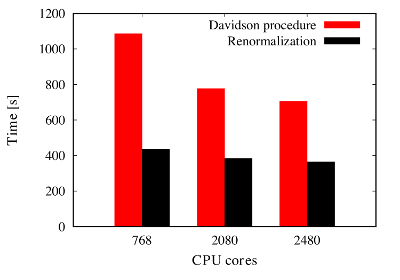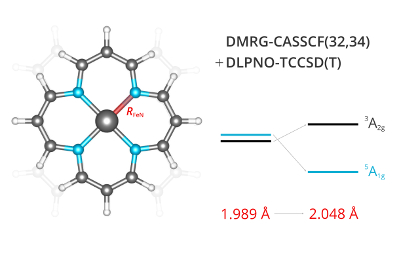We are interested/working in the following areas
Development of efficient DMRG-based computational methods for strongly correlated molecules

One of our main research interests is tensor network methods, which provide
efficient wave function parametrizations, particularly well-suited for
strongly correlated (multireference) problems. Even the simplest, so called matrix product states (MPSs), which are optimized by the density matrix renormalization group (DMRG) method, proved themselves as very robust and reliable tools. In fact, DMRG has been established as a reference method for electronic properties of systems requiring very large active spaces.
In collaboration with
Jiří Brabec (Heyrovský Institute),
Karol Kowalski (PNNL, USA), and
Örs Legeza (Wigner Research Center, Budapest), we have developed the
massively parallel version of DMRG, which can treat even larger active spaces and thus more complex systems. Our implementation has been further extended to support multi-GPU architectures.
In addition to the efficient DMRG implementation, we have e.g. recently extended DMRG to handle molecules in cavities under strong coupling with the electromagnetic field (QED-DMRG) or developed a machine-learning model that significantly enhances DMRG performance.
Selected publications:
Pavlo Golub, Chao Yang, Vojtěch Vlček,
Libor Veis, "Quantum Chemical Density Matrix Renormalization Group Method Boosted by Machine Learning",
http://arxiv.org/abs/2412.07607
Mikulas Matousek, Nam Vu, Niranjan Govind, Jonathan J. Foley IV,
Libor Veis, J. Chem. Theor. Comput., 20, 9424 (2024). DOI: https://doi.org/10.1021/acs.jctc.4c00986
Jiří Brabec, Jan Brandejs, Karol Kowalski, Sotiris Xantheas, Örs Legeza,
Libor Veis,
J. Comp. Chem. (2021). DOI:
https://doi.org/10.1002/jcc.26476
Applications of tensor network methods (DMRG in particular) on challenging strongly correlated problems

We do not only develop computational methods, but also apply them on interesting and challenging problems. Typical systems studied by DMRG are transition metal complexes. In collaboration with
Pavel Hobza's group at the Institute of Organic Chemistry and Biochemistry, we have recently studied the properties of low lying spin states of porphyrin-like molecules.
Other examples include multi-radical polycycylic aromatic hydrocarbons derivatives stabilized by metal surfaces, in collaboration with
Pavel Jelínek's group at the Institute of Physics.
Selected publications:
Federico Villalobos, Jan Berger, Adam Matěj, Reed Nieman, Ana Sánchez-Grande, Diego Soler, Andrés Pinar Solé, Hans Lischka,
Mikuláš Matoušek,
Jiri Brabec,
Libor Veis, Alba Milan, Carlos Sánchez-Sánchez, Araceli G. Campana, Juan M. Cuerva, Pavel Jelínek, accepted in
Chem (2024), DOI:
https://doi.org/10.1016/j.chempr.2024.09.015Shaotang Song, Andrés Pinar Solé, Adam Matěj, Guangwu Li, Oleksandr Stetsovych, Diego Soler, Huimin Yang, Mykola Telychko, Jing Li, Manish Kumar,
Jiri Brabec,
Libor Veis, Jishan Wu, Pavel Jelinek, Jiong Lu,
Nature Chemistry, (2024), DOI:
https://doi.org/10.1038/s41557-024-01453-9Andrej Antalík, Dana Nachtigallová, Rabindranath Lo,
Mikuláš Matoušek, Jakub Lang, Örs Legeza, Jiří Pittner, Pavel Hobza,
Libor Veis, Phys. Chem. Chem. Phys.,
22, 17033, (2020). DOI:
10.1039/d0cp03086d
Post-DMRG quantum chemical methods
DMRG itself is a very powerful multireference method, which can work with large active spaces. However, it lacks the dynamical electron correlation and its inclusion is important to achieve chemical accuracy.
Recently, in collaboration with
Katarzyna Pernal (Lodz University of Technology), we have developed the computational approach combining DMRG with the addiabatic connection (AC) technique to add the missing dynamical correlation. The AC methods achieve the accuracy similar to the second order perturbation theory, but have favourable scaling with the active space size.
To account for the effect of chemical environment (condensed phase/protein environment, etc.), we have developed the projection-based DMRG-in-DFT embedding.
In collaboration with
Jiří Pittner's group at the Heyrovský Institute, we have developed the DMRG-based tailored coupled clusters (CC), in which CC in some sense adds the missing dynamical correlation on top of the DMRG wave function.
Selected publications:
Pavel Beran, Katarzyna Pernal, Fabian Pavosevic,
Libor Veis,
J. Phys. Chem. Lett., 14, 716, (2023). DOI:
https://doi.org/10.1021/acs.jpclett.2c03298
Pavel Beran,
Mikulas Matousek, Michal Hapka, Katarzyna Pernal,
Libor Veis,
J. Chem. Theor. Comput., 17, 7575,
(2021). DOI:
https://doi.org/10.1021/acs.jctc.1c00896
Libor Veis, Andrej Antalík, Jiří Brabec, Frank Neese, Örs Legeza, Jiří Pittner,
J. Phys. Chem. Lett.,
7, 4072, (2016).
DOI: 10.1021/acs.jpclett.6b01908
Quantum computing for quantum chemistry
Quantum computers have a potential to change the way we are doing chemistry!
The idea of Feynman to simulate one quantum system on another and thus to avoid the complexity problems associated with simulations of quantum systems on a classical computer were 15 years ago brought also to quantum chemistry. Nowdays, quantum computing for quantum chemistry is a well-established and fast-growing discipline of theoretical chemistry.
While the development of large-scale universal quantum computers may still take some time, near-term devices with a limited number of qubits already offer promising opportunities to achieve tasks that are classically infeasible. These so-called Noisy Intermediate-Scale Quantum (NISQ) devices—systems that do not yet support full-fledged quantum error correction—provide a rich playground for hybrid quantum-classical algorithms. Developing these algorithms, which is an area we actively work on, is of great importance for advancing the field.
Selected publications:
Mikulas Matousek, Katarzyna Pernal, Fabijan Pavosevic,
Libor Veis, J. Phys. Chem. A, 128, 687 (2024). DOI: https://doi.org/10.1021/acs.jpca.3c07590
Yudong Cao, Jonathan Romero, Jonathan P. Olson, Matthias Degroote, Peter D. Johnson, Maria Kieferova, Ian D. Kivlichan, Tim Menke, Borja Peropadre, Nicolas P. D. Sawaya, Sukin
Sim, Libor Veis, Alán Aspuru-Guzik, Chem. Rev., 119, 10856, (2019). DOI: 10.1021/acs.chemrev.8b00803
Libor Veis, Jiří Pittner, J. Chem. Phys., 113, 194106, (2010). DOI: 10.1063/1.3503767